AV Survey Results 2019

“Sharing the Road” with Autonomous Vehicles Survey Results 2019
Background
Shortly after Uber began testing Semi-Autonomous Vehicles (AVs) on Pittsburgh’s streets in September 2016, Bike Pittsburgh launched a survey to capture how Pittsburghers who bike and walk feel about sharing the road with this new technology. Two years later, we relaunched the survey to see how Pittsburghers’ impressions of AV technology has changed. Timeline.
The original survey results, published in March 2017, surprised us when it revealed that Pittsburghers actually felt slightly more comfortable sharing the road with AVs than they did with human drivers. However, initial responses also found that many people have experienced close calls, such as AVs passing bicyclists within less than 4-feet, or failing to yield to pedestrians in crosswalks, both required by state law. This seems to be particularly problematic along Railroad St, a popular road for bikes, and where there were several reports of AVs passing closely near the railroad tracks where bicyclist frequently crash due to the odd angle of the tracks.
We also discovered that incidents happened and people had no place to share their experiences. There’s no “how’s my driving” sticker to report those close calls (although both Argo and Uber welcome feedback) and no place for the City to collect cases that don’t require a police report. This led us to launch our Submit Autonomous Vehicle Experience (SAVE) Form.
The mix of a rapidly developing technology (that is not yet fully autonomous) and the nature of how humans get around their city, has already ended in tragedy, when an Uber AV struck and killed Elaine Herzberg, a pedestrian walking with a bicycle in Tempe, Arizona.
The past two years saw other rapid changes in the AV industry, especially in Pittsburgh. Since Uber’s AV launch in 2016, several more companies have begun testing in Pittsburgh, the State of Pennsylvania passed Autonomous Vehicle Testing Guidance, and the Federal government is close to passing the AV START Act. Also, the technology has presumably gotten better.
Our elected leaders can help ensure Pittsburgher’s safety by setting the terms for how these companies operate, while still allowing them to develop their product. Therefore, we also looked into how Pittsburghers feel about proposed regulations and agreements, for example, the City’s recent request to limit cars in “autonomous mode” to 25 mph.
This follow up survey also aims to see how the landscape has changed, and how specifically, Pittsburghers on bike and on foot feel about sharing the road with AVs so that we’re all better prepared to deal with this new reality and help make sure that it is introduced as safely as humanly possible.
To be clear, our goal with this survey is to seek insight from the Pittsburghers who are literally some of the first people on earth to be sharing the road with robots on a day-to-day basis.
The technology is still in its infancy, so we feel it’s important for BikePGH to stay on top of the issue. In the meantime, it helps inform us as we are actively talking to these companies, and making sure they are aware of what it’s like to ride a bicycle and walk in Pittsburgh. We owe it to our members.
We’re under no illusion that AV technology will achieve their promises any time soon. So we must balance this work with a healthy skepticism. A failure in this emerging technology has the potential to kill and maim real people, real Pittsburghers. Despite the promised safety improvements, AVs will still maintain the car-oriented world we’ve been combatting for years, and has the potential to gut public transportation and the good union jobs that come with it. AVs will still pollute, will still cause traffic jams, and will still harm people who are just trying to get around.
Neither bikes, pedestrians or AVs are going away, so we have to find common cause and figure out how we can be mutually beneficial. For example, we’ve learned that like human drivers, AVs can navigate around people on bikes much better when there are bike lanes. We really like bike lanes too.
It’s important for us as an organization to gain as much knowledge about the technology as we can, so that we can pull the veil off of the things that don’t add up, but also make sure the companies create a safe product.
Key Findings
Results Published: FEBRUARY 5, 2019
Sharing the Road – First identified in our 2017 survey, people still feel safer “sharing the road” with AVs versus human drivers. This may be tapping into the frustrations that people have with human drivers.
Death of Elaine Herzberg – The death of Elaine Herzberg in Tempe, AZ negatively affected people’s opinion about sharing the road with AVs. However, there was a clear trend in how the tragedy didn’t affect their opinion of AV technology in general, but soured their opinion of Uber, and how the company handled it.
Regulations – People are clearly in favor of requiring AV companies to share useful information, including safety related incidents, with the appropriate authorities. It is less clear how people feel about regulations that prescribe what the companies can and can’t do during testing.
Edge Cases – In 2017, we identified some patterns that we found problematic. Specifically, there were several reports of AVs passing at less than the 4’ required by law. This comment was few and far between in 2019. However, there are several specific comments about AVs, who are impatiently passing people on bikes while riding on Railroad St in the Strip District, leaving us to question whether humans are better able to deduce odd scenarios, or “edge cases” than computers.
Policy Recommendations – Whether City, State, or Federal, our representatives are the ones who can enact policy to ensure that the public remains safe, while still allowing companies to develop their technology. We compiled a list of practical policy recommendations that we’d like to see.
Sharing the Road and Safety
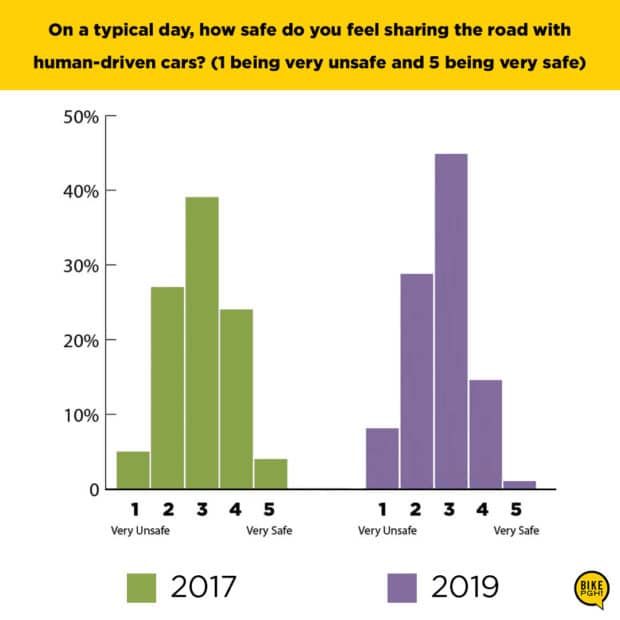
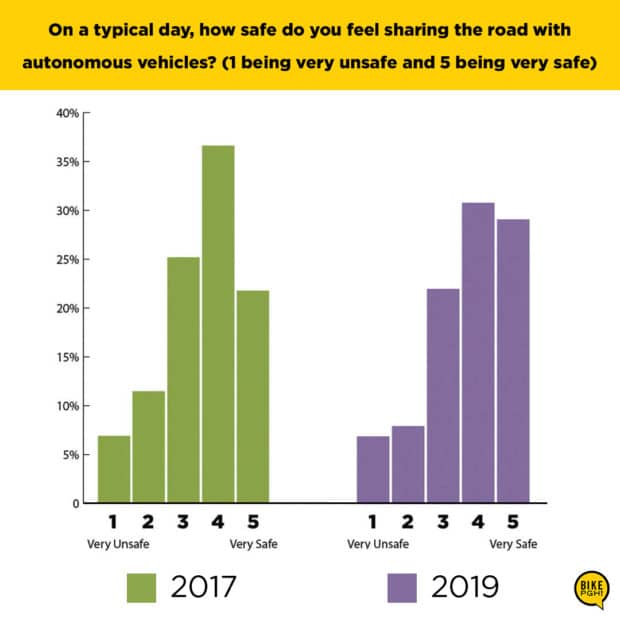
Similar to the original survey, respondents actually felt safer sharing the roadway with AVs than human drivers.
In a surprise to us, there was even a slight shift toward feeling safer around AVs, as well as a slight shift toward feeling less safe around human drivers.
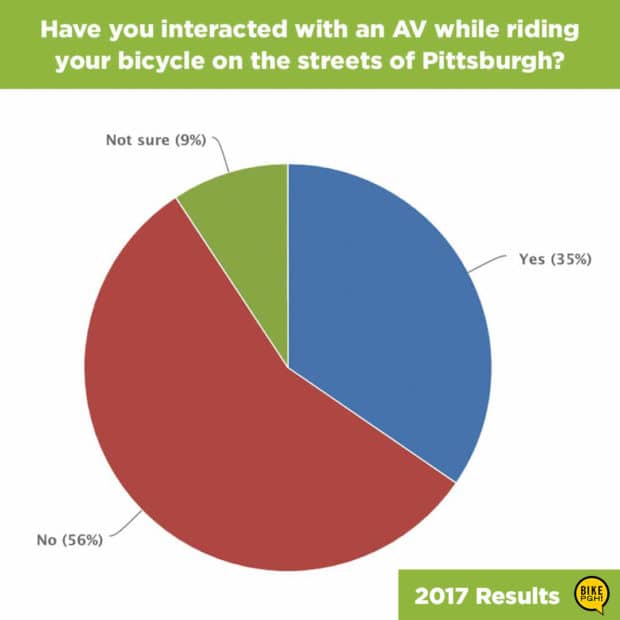

A variety of factors most likely contribute to this, such as: people feel the technology and/or safety drivers may have gotten better, they’ve become more used to the “creepy” factor, or they simply experienced fewer incidents. Not surprisingly, there was a significant rise in the number of people who have interacted with AVs while either walking or biking. In 2017, only 35% of respondents had shared the road with an AV while riding a bike, versus 53% in this survey. Likewise, in 2017 46% of respondents had interacted with an AV while walking, a significant rise from the 61% found today.
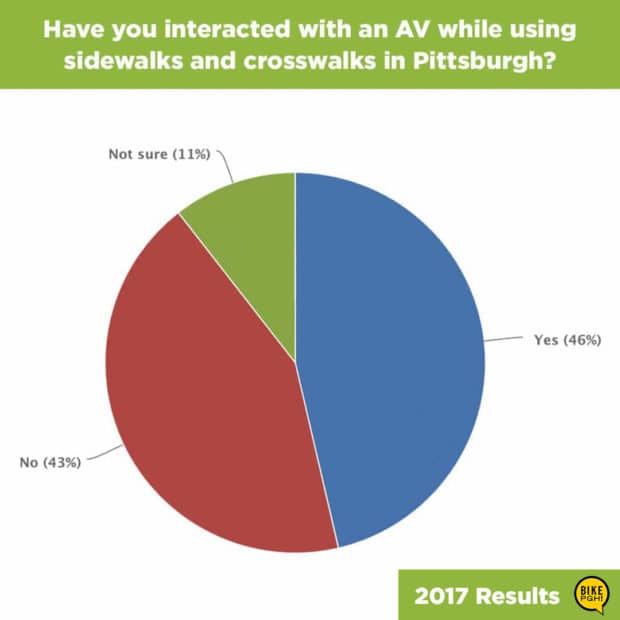

The open ended questions seem to confirm that people are getting used to seeing AVs.
Overwhelmingly, people used words like “unremarkable” or “nothing notable” to describe their interactions, which of course is good. This is a contrast to the previous survey where we saw many people who found the conservative driving unpredictable and disorienting, indicating that people are getting used to the car’s behavior.
For instance, in the 2016 survey, there were quite a few comments about how AVs were not passing them with the required 4-feet by Pennsylvania law, a main talking point of ours. In this survey, we saw very few complaints about unsafe passing distances (although they were still reported). In general, the sentiment was that the AVs acted as expected.

“Several years ago, I remember an AV passing me too close when on my bike. More recently (still a while ago – when Uber was on the road) an AV stayed behind me at a safe distance and matched my speed.”
Additionally, as people end up seeing AVs more frequently, they themselves fall into patterns, which may influence their overall experience sharing the road. Several riders claimed that they ride extra carefully when they see an AV. Conversely, there were also riders who admitted that they will frequently “test” the cars response to their actions.
Respondents feel that AVs have the potential to reduce injuries and fatalities on our streets. 72% said that AVs will significantly (38%) or slightly improve (34%) safety on the streets, with 13% thinking there will be no change. 15% think that AVs will make our streets slightly (10%) or significantly worse (5%).
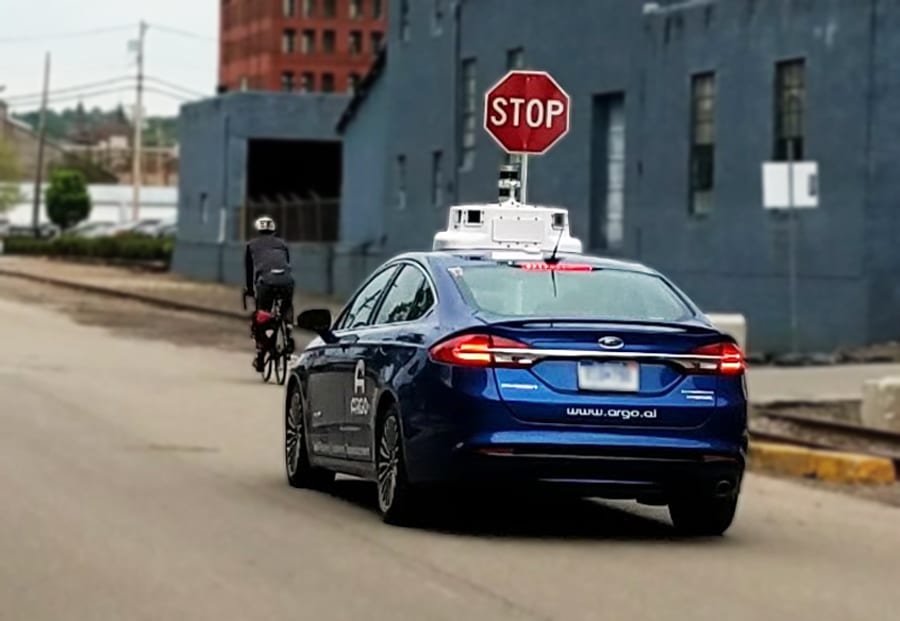
Edge Cases
However, there were also some comments revealing potential safety issues given the nuances of the street in question. A notable example of this involved Argo AI’s AVs on Railroad St in the Strip District. Railroad St is a low-vehicle street where, due to a lack of bike infrastructure in the Strip District, people on bikes often ride on in order to avoid the busy Smallman St, and one that Argo AI has been using as part of their testing route. There are two sets of tracks that cross the street at a severe angle, dangerous enough to warrant the City to install warning signs looking to instruct cyclists on how to properly cross the tracks, and as a warning to drivers to be careful because bikes will be making an unpredictable maneuver. In order to avoid crashing, people on bikes must approach the tracks as perpendicular as possible. We received comments from a few bicyclists about how AVs passed them in such a way that they felt it prevented them from safely maneuvering over the tracks in their typical fashion. It must be noted that, for years, there have been a numerous crashes involving bicyclists and these tracks both with and without cars in proximity to them. That said, it is still concerning that unique scenarios, or “edge cases,” like the example above may be more difficult for a computer to predict the bicyclist’s intentions than might a human driver.
It’s worth mentioning here that after Elaine Herzberg was struck and killed by an Uber AV in Tempe, that company suspended on-street testing. During this time the other operators seemingly increased their testing. After March of 2018, most people’s interactions were with Argo AI, so naturally there were more overall comments, both positive and negative, towards this company as they became the dominant AV company on Pittsburgh’s streets in Uber’s absence. We still think it is necessary to relate these stories that we become aware of in the hopes that they can help inform public policy, and so companies can further delve into these instances and address any issues from their side.
“I was biking down Railroad St. I came to a stop sign that had a railroad crossing and it felt like the AV didn’t see me as I was crossing the RR track at a 90 degree angle. Most cars/drivers when they see me at the intersection with my bike tire turned to cross the tracks stay back a little to give me room…I felt like I could just tell that the AV didn’t see that that was what I was doing/going to do.”
“This summer, when I would ride my bicycle in the opposing direction of the Argo AVs on Railroad Street, I did not feel that they were patient enough when I needed to cross the railroad tracks. Most specifically, the did not slow down as I maneuvered to cross the tracks at a 90 degree angle.”
This brings up the desire for transparency and a clear desire for a place to report incidents either to the City or directly to the companies themselves. As these incidents may not warrant a police report, and the cars don’t have a “how’s my driving” sticker, there is currently few mechanisms to let anyone who may be able to fix the problem aware of it in the first place.
In the meantime, BikePGH is keeping track of notable incidents, both the good and the bad. You can submit these to our S.A.V.E. Form.
“My opinion regarding the safety of AVs on the streets tends to sway back in forth. In one regard, I’m concerned that an AV might not accurately identify cyclists/peds, avoid bike lanes, etc. On the other hand, I know that human drivers are far more distracted and don’t pay attention at all.”
Pittsburgh as a Proving Ground
We found no significant change in people’s attitudes about Pittsburgh as a proving ground for AVs. Approximately 70% of respondents approve, while 19% disapprove, with the rest remaining neutral.


Many people cited their interest in seeing a new industry emerge in Pittsburgh. There were several comments that suggested that, since the companies are testing on public streets for free, they should be kicking in some funds to help support public transit, bike lanes, sidewalks and better roads. People fear that “ride-sharing” services are actually harming public transit and their workers, and feel this would be a good faith effort to prove otherwise.
Death of Elaine Hertzberg

One of the most significant events in the emergence of AV technology was when, in March of 2018, an Uber AV struck and killed Elaine Herzberg, a pedestrian, in Tempe, AZ. In our survey, we attempt to understand how this event and its outcome changed people’s opinion about sharing the road with AVs.
About 60%, claim no change in their opinion, with another 37% claiming that it negatively changed their opinion. Nearly 3% claimed their opinion changed positively toward the technology.
However, the question elicited very passionate, yet thoughtful open ended responses. Everything from: “The death in Arizona was a fluke, not a condemnation of AVs” to how people feel that “AVs are not yet ready for prime time.”
One point where there seems to be agreement is that the incident did not turn too many people off of AV technology in general. Rather it did lead to a growing distrust of the companies themselves, specifically with Uber and how they handled the fatality. Many respondents questioned the AV company’s motives and trustworthiness.
Read on to hear some of the respondents in their own words. We’ve included a lot because this is an import topic.
“In regard to the incident in AZ, the incident made me weary about the concerns of tech companies for the pedestrian and cyclist communities. I felt as though it was brushed off, and oftentimes made excuses that wound up blaming the victim. While I am still very hopeful for AV technology to increase the safety of our roadways, this incident raised some major concerns for corporate priorities and what was being done to put pedestrian and cyclist safety to the forefront.”
“With regard to [the Elaine Herzberg fatality], this was a failure of the human driver and the poor processes employed by Uber during testing, so it didn’t change my perception of AV’s but did of Uber and the fact they and other AV companies need to be more open and have better processes.”
“What Uber allowed to happen to Elaine was careless. I don’t think the incident affected my opinion on AVs at all, but it DEFINITELY affected my opinion on Uber’s leadership, especially in the way they tried to shirk responsibility and blame first Elaine, then the driver, then finally, pointing the finger at themselves. I wouldn’t have allowed them to go back onto Pittsburgh’s roads as soon as we did.”
“The Tempe incident made me feel more negative about the Uber releasing footage that made it appear that the pedestrian wasn’t visible, by clearly darkening the exposure.”
“Algorithms are going to need tweaking over time and improvement. Accidents will happen. Trying to make excuses with doctored video releases to the public will only hurt our trust.“
“The death of Elaine Herzberg really shows to me the depth of ignorance that these companies can have toward cyclists and pedestrians.”
“I’d urge people to not take a single, tragic accident (Elaine Herzberg) as a condemnation of the technology. I fear that knee-jerk reactions will cause some to think we shouldn’t be pushing forward with autonomous vehicles. Let’s not forget the 5,987 pedestrian fatalities in 2016”
“The above event with Elaine didn’t change my opinion about sharing the road with AVs but it did change my opinion and view about how the AV companies operate, share data, and make decisions that affect the public”
“The incident with Elaine Herzberg significantly decreased my opinion of Uber’s AV (and my opinion was already pretty bad). I don’t think Uber has been testing them in a safe manner. I don’t think their practices apply to all companies AV however, and that a company should be significantly penalized for their AV doing illegal things so that companies wait until their technology is tested well in simulators and ready for the roads.”
“The Tempe crash is important. Initially, I did not care much. There was always going to be a first AV fatality, and human drivers kill people all the time without it being national news. However, news has come out that the vehicle DID notice the pedestrian and did nothing to avert the instance. AVs need to be more tightly regulated, and companies should have high liability in any accidents during testing on City streets.”
“I was initially very excited about them and still am. It’s a fascinating technology! I still think that they have the potential to improve safety for bicyclists and pedestrians — if nothing else, by obeying standoff distances and not deliberately harassing cyclists and walkers.”
“AVs are not yet ready for prime time. Cyclist and pedestrian detection software still makes potentially dangerous errors, for instance. The fatal accident in Arizona revealed that safety considerations played a back seat to rapid development, especially when performance targets were on the line.“
Regulations
On regulations, our respondents seem to have mixed feelings, at least in terms of how authorities should regulate what they can and can’t do. For instance, there was an even split between “yes,” “no,” and “not sure” on whether AVs should be limited to 25mph in autonomous mode, as well as whether there should be two safety drivers in the vehicle at all times.
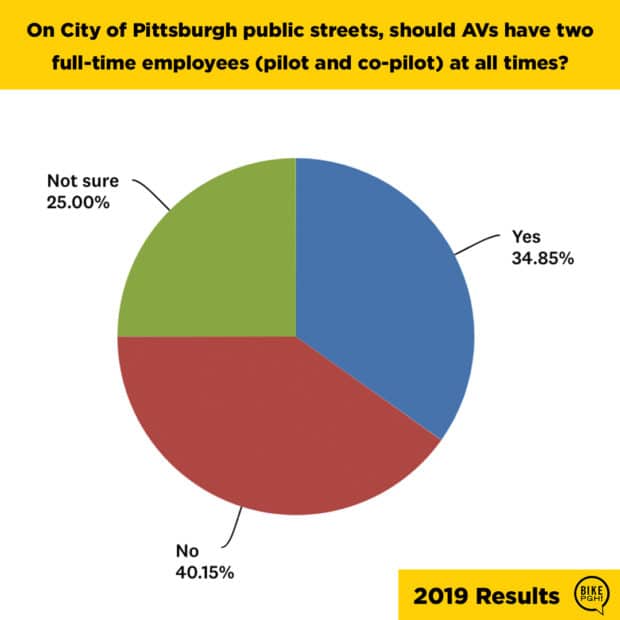
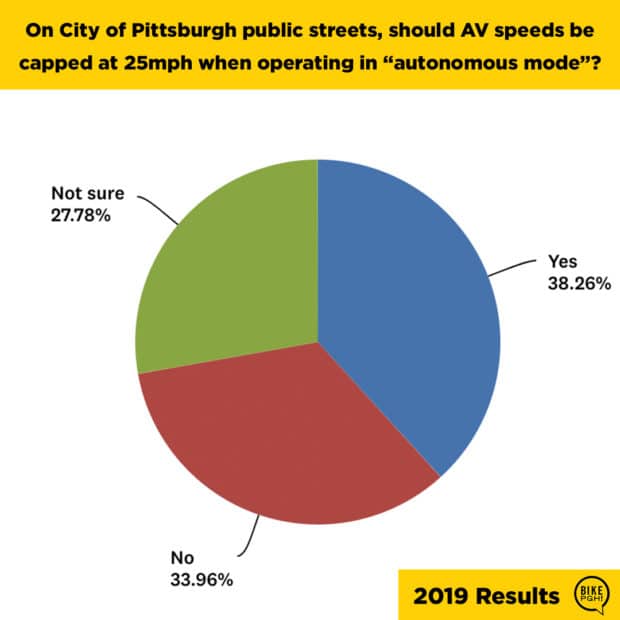
One regulation that people seem to support is to require the cars to run in manual mode within an active school zone.
The large number of “not sure” responses indicates that more education needs to occur surrounding these issues. While some companies, such as Argo, voluntarily require drivers to take over within active school zones or around emergency vehicles, we’d like to see this be standardized.
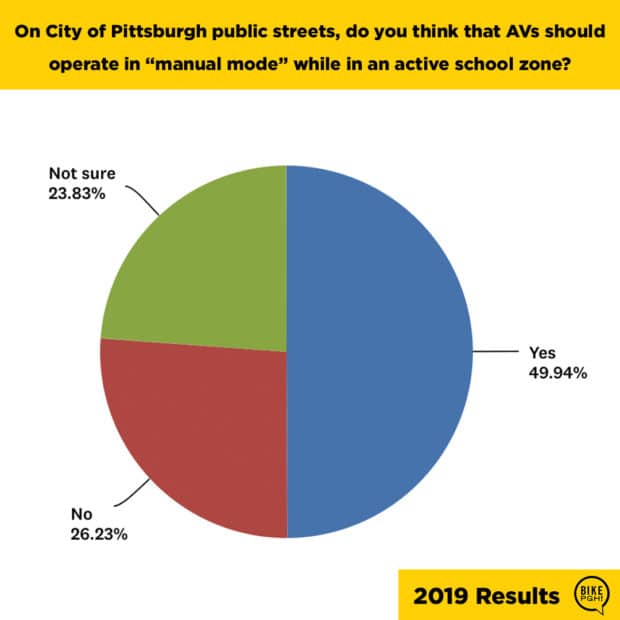

However, there is undoubtedly a consensus when it comes to making sure authorities are informed about the safety and performance of the vehicles. On the three questions that we asked, people were overwhelmingly in support of the companies being required to report on the safety limitations and capabilities, report incidents even if a police report isn’t required, and share non-personal data (e.g. number of trips, pickup/drop off locations, number of miles driven) with the proper authorities. Mainly, they felt that these were things that were for the good of safety and the community, and a small price to pay for using City streets for free.


“These companies need to understand they operate at the convenience of the citizens/city not the other way around.”
Finally, something new this time around, we received several concerns about an increase in emissions and a worsening of air quality due to the increased traffic that AVs provide.
“The AVs should at the very least be electric so they don’t add to the poor air quality that we already experience, especially as cyclists and pedestrians breathing in car exhaust, especially as they are just driving around and not actually moving people anywhere.”
Demographics
We solicited responses from our website, our email list, as well as a few news articles. In total 795 people took the survey, compared to 1,119 in 2017. 610 of these hailed from the 152 zip code prefix, indicating Pittsburgh and surrounding municipalities. The next largest zip code prefix with 68 responses began with 151, indicating that they live in the Pittsburgh vicinity.
Nearly 50% of respondents claim to be members of BikePGH. 94% of respondents have access to an automobile in their household, while 96% of respondents own a smartphone.
The largest share of responses (26%) came from the 25-34 age range, with less than 5% of responses coming from people under 24 years of age. The other age ranges are fairly evenly split: 35-44 (22%), 45-54 (15%), 55-64 (18%), and 65+ (12%)
Knowledge of the subject
Not surprisingly, people feel much more informed about AVs this time around, compared to the 2017 survey.
People are paying attention to news about AVs more than they were, and feel like they have a better understanding of the technology that drives the cars. In short, they seem to be getting used to seeing them.
When asked how familiar they are with the technology behind autonomous vehicles, responses include: Extremely Familiar (21%), Mostly familiar (32%), Somewhat familiar (38%), and Not familiar at all (9%).
When asked about paying attention to the subject of AVs in the news, only 6.5% admitted that they are not reading much about the subject, compared to 11% from 2019. 73% now claim that they pay attention to a large or moderate extent, compared to 59% in the previous study.
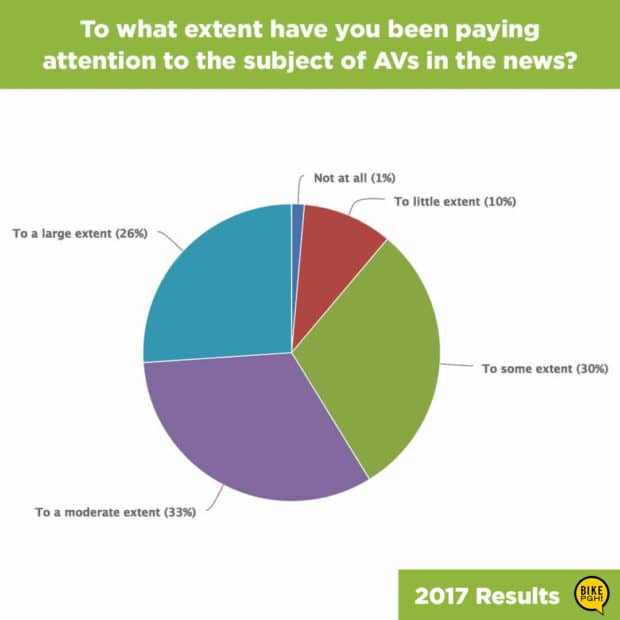
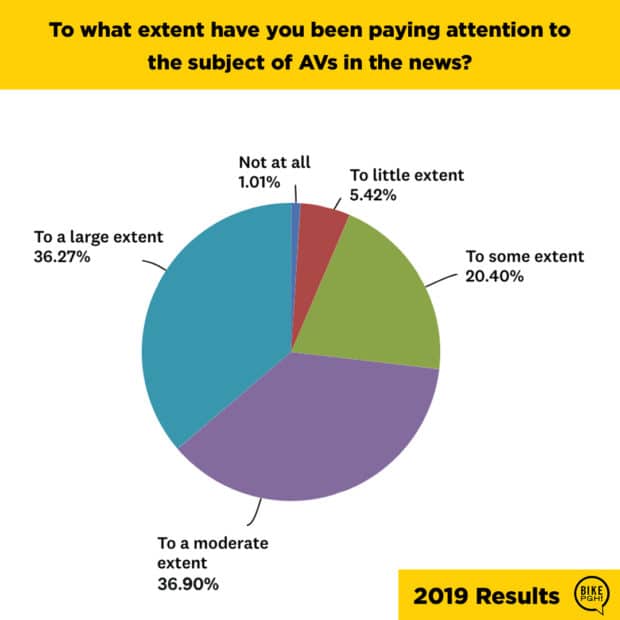
Data
Just like last time, we will release a scrubbed version of the data (to ensure no identifying information) to the Western Pennsylvania Regional Data Center (WPRDC). We are happy to share the full data with those using it for non-commercial academic research.
Policy Recommendations
Locally, there are conversations on how the City interacts with the companies. While legislation is unlikely to happen (and may not be allowed at the City level), the City can create agreements in which they strongly suggest companies comply as a good-faith partner in exchange for using public streets as a test bed. In addition to the recommendations that PennDOT recently laid out, we’d like to see the following policies in place regarding AVs.
- The City should institute a protocol for AV companies to report safety-related incidents, even if a police report isn’t filed.
- AV companies should work with the City to establish a place where residents can report incidents related to a car’s performance.
- The car and company should be easily identifiable.
- AV companies should be required to maintain two safety drivers in the car at all times. Companies must clearly and transparently demonstrate what triggers their decision to only use one driver.
- While some companies, like Argo, voluntarily drive 25mph and below within the City, AV companies in general should not be able to operate in autonomous mode above 25mph within city limits.
- AV companies should be transparent and disclose information and data as to the limitations, capabilities, and real-world performance of their cars.
- AV companies should provide non-personal/anonymized data, like pick up/drop off locations, number of miles driven, etc. that could help planners create a better transportation system.
- AV companies should avoid driving in autonomous mode within an active school zone.
- AV companies should need to pass a vision test that would prove automated vehicles could both detect and respond to bicyclists, pedestrians, people in wheelchairs and others. The League of American Bicyclists is leading this advocacy on the national stage.
- Complete Streets. Just as bike lanes and crosswalks make it easier for human drivers to share the road with people on bikes or on foot, the same is true for robot driven cars. Therefore, it’s necessary for the City to implement and maintain clear and safe infrastructure for pedestrians and bicyclists.
Credits
Release date: February 5, 2019
Survey design and management: Eric Boerer
Web layout design, images, and charts: Alexandria Shewczyk
Special thanks to the Western Pennsylvania Regional Data Center, Ngani Ndimbie, Uber, and Argo AI. And a huge THANK YOU to BikePGH members and volunteers.
